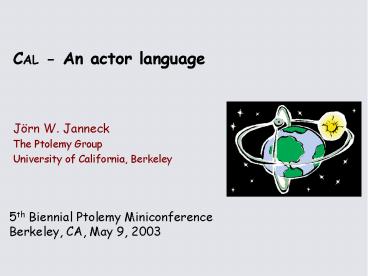CAL - An actor language - PowerPoint PPT Presentation
Title:
CAL - An actor language
Description:
actor writing requires considerable skill. BUT: Actors have a lot of common structure. ... actor descriptions contain a lot of 'admin' code. local precedent: ... – PowerPoint PPT presentation
Number of Views:143
Avg rating:3.0/5.0
Title: CAL - An actor language
1
CAL - An actor language
- Jörn W. Janneck
- The Ptolemy Group
- University of California, Berkeley
2
CAL people
- Chris Chang
- Johan Eker (now Ericsson Mobile Platforms,
Research) - Ernesto Wandeler (ETH Zurich)
- Lars Wernli (then ETH Zurich)
- Ed Willink (Thales Research)
- Yang Zhao
3
Why another language?
- Writing simple actors should be simple.
- Ptolemy II API very rich
- actor writing requires considerable skill
- BUT Actors have a lot of common structure.
- Models should allow efficient code generation.
- actor descriptions contain a lot of "admin" code
- local precedent
- ptlang in Ptolemy Classic (J. Buck)
4
Why another language?
- We should generate actors from a more abstract
description. - reduces amount of code to be written
- makes writing actors more accessible
- reduces error probability
- makes code more versatile
- retargeting (other platforms, new versions of the
Ptolemy API) - analysis composition
5
Simple actors
actor ID () In gt Out action a gt a
end end
actor A (k) Input1, Input2 gt Output
action a, b gt k(a b) end end
actor Merge () Input1, Input2 gt Output
action Input1 x gt x end action
Input2 x gt x end end
actor firing º execution of one enabled action
6
An actor with state
actor Sum () Input gt Output sum 0
action a gt sum do sum sum
a end end
7
Action guards
actor FairMerge () Input1, Input2 gt
Output s 0 action Input1 x gt
x guard s 0 do s 1
end action Input2 x gt x guard s
1 do s 0 end end
- action
- input patterns declaring variables
- guard specifying enabling conditions
- output expressions computing output tokens
- body modifying the actor state
8
Action schedules
actor FairMerge () Input1, Input2 gt
Output A action Input1 x gt x end B
action Input2 x gt x end schedule fsm
State0 State0 (A) --gt State1
State1 (B) --gt State0 end end
actor FairMerge () Input1, Input2 gt
Output s 0 action Input1 x gt
x guard s 0 do s 1
end action Input2 x gt x guard s
1 do s 0 end end
actor FairMerge () Input1, Input2 gt
Output A action Input1 x gt x end B
action Input2 x gt x end schedule
regexp (A B) end end
9
First-class functions
actor Sieve (predicate) Input gt Output
filter lambda (a) false end action a
gt guard filter(a) end action
a gt a guard not filter(a) var f
filter do filter lambda(b)
f(b) or predicate(b,a)
end end end
10
Programming language features
- optionally typed
- generic polymorphic type system
- full functional sub-language
- everything first-class citizen (well, almost)
- functions
- procedures
- NOT actors or actions (yet)
- lexically scoped
- no aliasing of stateful structures
- useful for handling concurrency
11
Executing CAL Interpreter
- Ptolemy actor
- configured by CAL script
- smooth embedding into Ptolemy II
- first version in current release
- domain-dependent interpretation(Chris Chang)
- interpreter adapts to domain
- making actors more domain-polymorphic
- What's a model of computation?
12
Executing CAL Translators
- XML for representing actors (CALML)
- persistent format
- infrastructure for checking, transformation
- XSLT as implementation language
- analysis
- program transformation
- code generation
CAL
CALML
Canonical CALML
generic Java
generic C
Pt/Java(UCB)
Palsjo/Koala(Lund)
JGrafChart(Lund)
...
...
13
Executing CAL Composer/Translator
CAL
A
C
CALML composition
CALML
B
codegeneration
CAL
CAL
a Ptolemy II model
14
Executing CAL Discovering concurrency
15
Conclusion
- CAL is a Ptolemy scripting language
- simple, portable description of actors
- can be analyzed, interpreted, compiled, composed
- new research directions
- composers as models of computation
- composer languages?
- infrastructure for executing actors
- component models, execution environments
- transformations/analyses of actor networks
- distribution
- efficient translation
16
Thank you.
resources www.gigascale.org/caltrop contact
janneck_at_eecs.berkeley.edu































